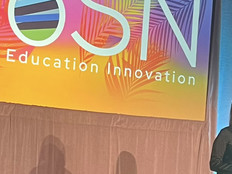EDTECH: What are educational technology trends or opportunities for innovation that you are exploring because of expanded remote learning?
JUAREZ: The students in the district I serve are from low socioeconomic–status households, and many lack reliable internet connections. That means many also rely on their mobile phones to connect to online learning. With that in mind, I started developing ideas and strategies that I like to call “phone friendly.” The purpose is to design distance learning experiences that students can interact with using a mobile phone. It takes into consideration mobile apps and ways to limit the amount of data consumed for students who are on limited data plans.
EDTECH: How are you recreating a classroom environment for virtual learning?
JUAREZ: I created my own Bitmoji classroom and developed a solid balance of synchronous and asynchronous activities for students. I also make sure to be available to students on a variety of platforms, including e-mail, Google Classroom, Google Voice, Remind and a class Facebook group.
EDTECH: How has the pivot to remote learning permanently changed the way you do your job?
JUAREZ: My job has changed in that my coaching services are in-demand like never before. Though I prefer to coach educators face-to-face, I am now a veteran of conducting professional learning and coaching remotely. In the past, I tried to schedule virtual office hours, and nobody showed up. Now, even when we go back to face-to-face teaching and learning, I’m confident that teachers will reach out for virtual support.
READ MORE: How are educators embracing the opportunities of online learning?
EDTECH: How are you, or the teachers you work with, using existing technology in new ways?
JUAREZ: Our teachers have had laptops with webcams for years. The struggle, previously, was getting them to use all of the features to create more interactive lessons. In the past, the laptop was merely for word processing and entering grades. But now, teachers are becoming their own version of Khan Academy by screen casting and recording lessons.
They are definitely starting to maximize the potential of their laptop’s cameras and microphones. Many are beginning to connect second screens and use plug-and-play microphones. I’ve also helped many of my teachers use their document cameras, tablets and phones as digital whiteboard to conduct guided instruction for live video lessons and screencasts.
EDTECH: How are you encouraging your peers to use technology for teaching and learning, now and in the future?
JUAREZ: Due to the current situation, I would say there isn’t much encouragement needed. Rather, it’s a constant need to be available for support. Each teacher is different and requires his or her own special style of support. For me, it’s encouraging to see many teachers innovate upon the ideas that I’ve coached them on, as well as seeing them get excited about their own professional learning, and growing a professional learning network.
Editor’s Note: This Q&A is part of a series featuring educators and technology experts from our 2020 K–12 IT Influencers list, weighing in on the innovations happening in their school community and in education at large during remote learning. Check out the second and third articles of this series.











